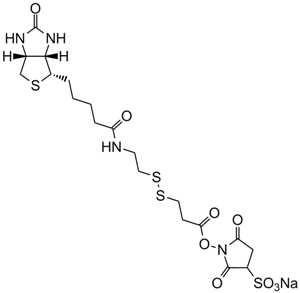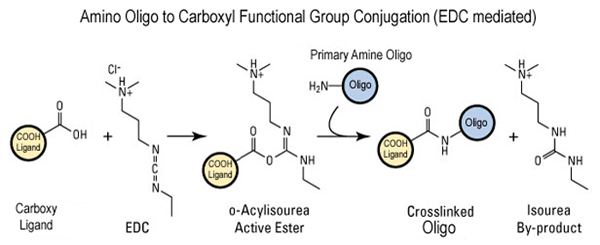
Modification : Biotin-SS-NHS-Sulfo
Catalog Reference Number
Category
Modification Code
5 Prime
3 Prime
Internal
Molecular Weight (mw)
Extinction Coeficient (ec)
Technical Info (pdf)
Absorbance MAX
Emission MAX
Absorbance EC
| Catalog No | Scale | Price |
| 26-6994-05 | 50 nmol | $270.00 |
| 26-6994-02 | 200 nmol | $270.00 |
| 26-6994-01 | 1 umol | $810.00 |
| 26-6994-03 | 2 umol | $1,242.00 |
| 26-6994-06 | 5 umol | $3,645.00 |
| 26-6994-10 | 10 umol | $6,102.00 |
| 26-6994-15 | 15 umol | $8,100.00 |
Click here for a list of other Affinity Ligand Modifications.
Sulfo-NHS-SS-biotin(sulfosuccinimidyl-20(biotinamido)ethyl-1,3-dithiopropionate) is a long-chain cleavable amine-reactive biotinylation reagent. The SS when reduced to SH will cleave the molecule. Biotin-SS-NHS is an N-hydroxysuccinimide ester (NHS ester) of biotin. Biotin-SS-NHS can be used to internally label an oligonucleotide with biotin SS at a base (that is, at a T, G, C, or A position) or a the ends. To accomplish this, amino dT-C6/dG-C6/dC-C6/dA-C6 is first incorporated internally into the oligonucleotide or an amino modifier at the ends, thereby placing an active primary amino group at the desired position. Biotin-SS-NHS is then conjugated to the amino group in a separate reaction to form the final biotin-SS labeled product.
YIELD
NHS based modifications are post synthesis conjugation performed using a primary amino group. The yield is lower as compared to direct automated coupling of modifications that are available as amidites. Approximate yield for various scales are given below.
~2 nmol final yield for 50 nmol scale synthesis.
~5 nmol final yield for 200 nmol scale synthesis.
~16 nmol final yield for 1 umol scale synthesis
~160 nmol final yield for 10 umol scale synthesis
~240 nmol final yield for 15 umol scale synthesis
Biotin is an affinity label that can be incorporated at either the 5’- or 3’-end of an oligonucleotide, or at an internal position. Biotin has a high affinity for the bacterial protein, streptavidin, which can be conjugated to a solid support (such as magnetic beads) for use as a capture and immobilization medium for a biotinylated oligo. In the biotin phosphoramidite, the biotin is attached to a long spacer arm, which acts to minimize steric hindrance between the biotin moiety and the oligo, thereby providing streptavidin easy access to the biotin. Biotinylated oligos are most commonly used as probes or primers in a variety of in vitro and in vivo applications.
Besides their importance as nucleic acid probes, biotinylated oligonucleotides are also useful for the purification of DNA binding proteins. In this context, the biotinylated oligonucleotide can be bound to a streptavidin matrix and used for either column or spin chromatography. For isolation of DNA binding proteins, the streptavidin-biotin-oligonucleotide complex is incubated with a crude cell extract containing nuclear proteins. Following appropriate washes, the proteins that bind selectively to the oligonucleotide sequence can be eluted under conditions that disrupt the protein:DNA complex. Because the binding of biotin to streptavidin is essentially irreversible and is resistant to chaotropic agents and extremes of pH and ionic strength, the elution conditions can be relatively stringent.

-
The primary amine labelled oligos can also be conjugated to carboxyl functional groups usually for solid supports applications using EDC mediated reaction as shown in the figure below.

- Biotin-SS-NHS-Sulfo
